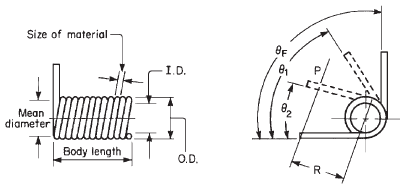Related Resources: spring material
Coil-Diameter Tolerances of Torsion Springs Specifications
Coil-Diameter Tolerances of Torsion Springs Specifications
Torsion springs with coils that are close-wound (touching) are most economical. Wire-diameter tolerances, which are usually quite close, then govern the dimensional variations in body length and therefore in the spacing of the spring arms. If the spring is close-wound (or the intercoil space in open-wound coils is smaller than the wire diameter), the springs do not tangle when shipped in bulk. Thus the cost of special packing is avoided. Machine setup time is lower with torsion springs that are closewound than with those which have small intercoil separation because tool adjustment must be more precise with the latter to avoid adjacent coils touching and affecting spring torque.
The types of ends on torsion springs should be considered carefully. While there is a good deal of flexibility in specifying special ends, the cost may be increased and a tool charge incurred. The longer and more extensively formed the ends, the higher is the cost for tooling and secondary operations. Therefore, short, straight ends should be specified whenever possible. Minimum end lengths are usually 3 times wire diameter on one end and at least tangent to the coil outside diameter on the other end.

Where:
D = Mean coil diameter (in)
d = Wire diameter (in)
Coil-Diameter Tolerances of Torsion Springs, ± in.
Wire diameter in |
Spring index, D/d* |
||||||
4 |
6 |
8 |
10 |
12 |
14 |
16 |
|
0.015 |
0.002 |
0.002 |
0.002 |
0.002 |
0.003 |
0.003 |
0.004 |
0.023 |
0.002 |
0.002 |
0.002 |
0.003 |
0.004 |
0.005 |
0.006 |
0.035 |
0.002 |
0.002 |
0.003 |
0.004 |
0.006 |
0.007 |
0.009 |
0.051 |
0.002 |
0.003 |
0.005 |
0.007 |
0.008 |
0.010 |
0.012 |
0.076 |
0.003 |
0.005 |
0.007 |
0.009 |
0.012 |
0.015 |
0.018 |
0.114 |
0.004 |
0.007 |
0.010 |
0.013 |
0.018 |
0.022 |
0.028 |
0.172 |
0.006 |
0.010 |
0.013 |
0.020 |
0.027 |
0.034 |
0.042 |
0.250 |
0.008 |
0.014 |
0.022 |
0.030 |
0.040 |
0.050 |
0.060 |

Torsion Spring End configurations